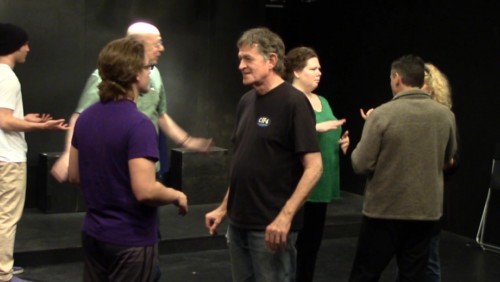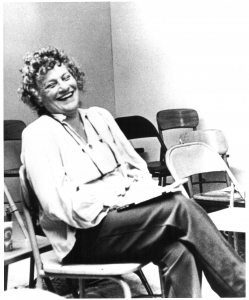
The concept of No-Motion is a quiet holding onto a moment for as long as one can, before it becomes static. As you go into no-motion it is both a thing to do and a thing to hold (like a mantra). When in No-Motion you are the eye of the storm. Viola compared it to a quarterback running down a field with perfect awareness of the melee around him, but not panicked or urgent. Now we are all familiar with language of film. It is used as a dramatic device: When you see someone in a peak moment of action on screen, the director will often cut the sound and slow the film, (other than breathing or some rhythmic beat) to show how focused the actor is within the raging action. You need a still mind and a way to rest within the beat of a scene. Thought must slow. If your mind races with ideas of what to do when you come out of “no-motion”, you were never in it.
Freezing is not relaxing and does not quiet the head. It shuts you off; Isolates you and leaves each player in their head. “What can I do to come out of Freeze with a good idea or offer?” “If my idea is first, I will trust my fellow players to “Yes, and…” it. But you will have initiated something without the benefit of relation with your fellow players. If together you hold a moment, in no-motion it might transform, frame by frame and you’ll be ready with whatever is going on between you when called back into action. It’s a pregnant pause. A shared knowing, A quiet connection. Follow the Follower!! As a split focus, you can be in action (i.e. washing the dishes) and holding a wish, emotion, or some other dramatic thing in No-Motion, never bringing it into action and it will color all you do. (See “Hold It” and “What’s Beyond”)

I’ve been thinking about “no motion” and trying to further process it. In my mind, it’s one of the more complex, but powerful, concepts in Viola’s work. I’ve read your descriptions here (and also for the “No Motion Warmup” post), and there were a couple of points you’ve noted that are really starting to get it to sink in for me.
1. The first is when you’re equating it to following the follower (and your blog post on the distinction between “yes, and” and “follow the follower” put everything in a new light for me – I ran across that maybe six months ago, or so, before taking your class, and found it incredibly insightful, and all the more so for distinguishing Viola’s work from the approaches that Second City and others use). While a freeze may allow “yes, and” thought processes, that is very much “in the head” and not “in the space.” No motion allows the connection for follow the follower to develop and craft a more meaningful and nuanced scene.
2. The second is your observation that, “As a split focus, you can be in action (i.e. washing the dishes) and holding a wish, emotion, or some other dramatic thing in No-Motion, never bringing it into action and it will color all you do. (See “Hold It” and “What’s Beyond”).”
In looking at how Viola described it, I’ve found the most useful descriptors – for me, or how my mind works – to be, “Keeping out of their own way,” “move effortlessly without conscious volition,” “a resting or non-thinking area between people precisely when they are busy with on-stage dialogue and activity,” “does not mean holding back of inhibiting an emotion or a verbalization,” [all from Improvisation for the Theater, 3rd edition], “a waiting (not waiting for, but in waiting)”, consistent with “take a ride on your own body,” and “in action without attitude” [from Lone Actor].
I think my “hangup” has been, in part, being too literal with the words, “no motion,” rather than fully appreciating the context which, admittedly, is still complex. Knowing that there is action happening (the frames of the film) but occupying a space between the frames in that readiness to follow-the-follower (“no motion”) is a powerful idea. Using the image of a flip-book or film frames is useful for getting there, but then that opens up a whole new world of possibilities to the actor in the scene, by virtue of the organic follow-the-follower rather than the structured world of “offers” and “yes and.”
I’m still grappling with this, but it helps to get ideas in writing, and to appreciate the work that you’ve put in to distilling the essence of this provocative concept.
(To the readers: This is a continuation of our discussion about the difference in the effect of Preoccupation and No-Motion via e-mail)
Hi Gary,
The effect of preoccupation is pretty much written out on “PreoccupationA”(p122) and “B”(p148). If you replace preoccupation with No-Motion in “B”, how will it differ in terms of its effect?
Hi Aki,
Good question. As I said before, Pre-occupation is an “Active” focus. You are asked to be active on two different fronts. When you are preoccupied, say, with verbalizing your private thoughts while sharing the where and dealing with an onstage activity that you share with another player, BOTH focuses will act on each other and lead you towards transformation. Refer to my blog post https://spolingamesonline.org/the-genius-of-preoccupation/.
However No-Motion is a quieter version as you dwell quietly on whatever you put in no-motion and let if affect your onstage activity. Both will bring into focus a vivid relationship, but No Motion allows you to have what Viola called ‘artistic detachment’. The focus permeates or colors or enhances the onstage active focus. No Motion allows you to have space between the action and it is filled in with what you would like.
For example while in a scene, you can put the sounds of your environment in No-Motion while you interact with your fellow players. Noticing won’t do anything but add another level to your work. Or you can put Smells in No Motion.
But I understand if you put something like “Regret” or “hidden anger” then it would be more like a pre-occupation.
They are similar, but to me they create different energies. Both very stage worthy and worth exploring.
Aki,
On page 176 of Improvisation for the Theater, in her explanation of No-Motion, Viola states “It [No-Motion] is the preoccupation that holds the energy content of the scene.”